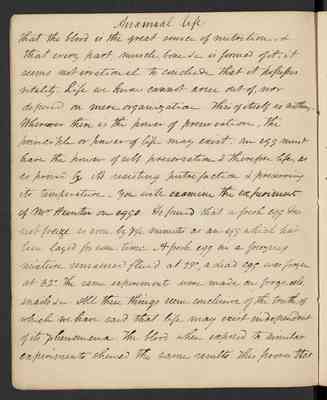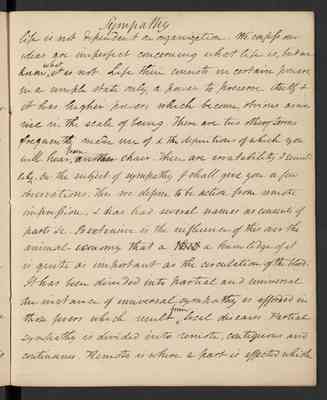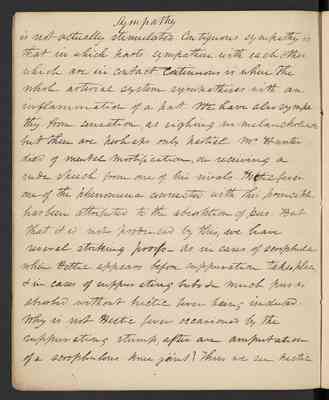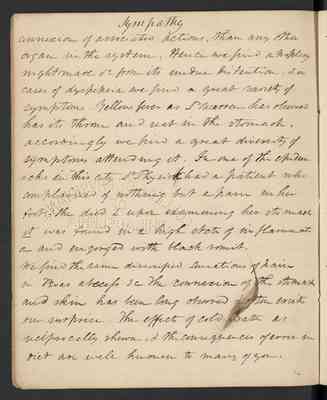Pages
6
Anaimal Life
that the blood is the great source of nutrition, & that every part, muscle, bone c is formed of it, it seems not irrational to conclude that it possesses vitality. Life we know cannot arise out of, nor depend on mere organization. This of itself is nothing. Wherever there is the power of preservation, the principle or power of life may exist. An egg must have the power of self preservation and therefore life, as is proved by its resisting putrefaction and preserving its temperature. You will examine the experiments of Mr. Hunter on eggs. He found that a fresh egg does not freeze so soon by 7½ minutes as an egg which had been layed for some time. A fresh egg in a freezing mixture remained fluid at 29°, a dead egg was frozen at 32°. The same experiments were made on frogs, eels, snails, c. All these things seem conclusive of the truth of which we have said that life may exist independent of its phenomena. The blood when exposed to similar experiments showed the same results. This proves that
7
Sympathy
life is not dependent on organization. We confess our ideas are imperfect concerning what life is, but we know what it is not. Life then consists in certain powers, in a simple state only, a power to preserve itself & it has higher powers, which became obvious as we rise in the scale of being. There are two other terms frequently made use of & the definitions of which you will hear from another chair. These are irratability & sensibility On the subject of sympathy I shall give you a few observations. This we define to be action from remote impression, and has had several names as consents of parts c. So extensive is the influence of this over the animal economy that a a knowledge of it is quite as important as the circulation of the blood. It has been divided into partial and universal. An instance of universal sympathy is afforded in these fevers which result from local diseases. Partial sympathy is divided into remote, contiguous and continuous. Remote is where a part is affected which
8
Sympathy
is not actually stimulated. Contiguous sympathy is that in which parts sympathise with each other which are in contact. Continuous is where the whole arterial system sympathises with an inflammation of a part. We have also sympathy from sensation, as sighing in melancholia c but these are perhaps only partial. Mr. Hunter died of mental mortification, on receiving a rude speech from one of his rivals. Hectic fever one of the phenomena connected with this principle, has been attributed to the absorption of pus. But that it is not produced by this, we have several striking proofs—As in cases of scrophula, when Hectic appears before suppuration takes place, & in cases of suppurating bubo &c much pus is absorbed without hectic fever being induced. Why is not Hectic fever occasioned by the suppurating stump, after an amputation of a scrophulous knee joint? Thus we see hectic
9
Sympathy
is not to be explained by suppuration. Formerly all kinds of medicines were thought to act upon the system by being taken into the circulation. Sympathy can explain this operation much more satisfactorily. We may here notice the sympathy between the schneiderian membrane and the lachrymal sac & gland—when this membrane is [irrated], these secrete and discharge a deluge of tears which washes the nostril. Light irrated and causing the contraction of the pupil another instance. The nose, throat, and fauces sympathise with the diaphram hence sneezing c. The bladder urethra & glans penis sympathise reciprocally. A calculus in one of the kidneys produces pain in the other. Inflammation of eye is often communicated to the other, and after removing a piece of iron filing from the surface of the eye (an operation which I frequently performed with my pen knife) I find most uniformly that on the ensueing day, inflammation succeeds in the other eye. The stomach has a more extensive
10
Sympathy
connexion of associated actions, than any other organ in the system; Hence we find a apoplexy nightmare c from its undue distention, & in cases of dyspepsia we find a great variety of symptoms. Yellow fever as Dr. Warren has observed has its throne and seat in the stomach, accordingly we find a great diversity of symptoms attending it. In one of the epidemdicks [sic] in this city Dr. Physick had a patient who complained of nothing but a pain in her foot. She died & upon examining her stomach it was found in a high state of inflammation and engorged with black vomit.
We find the same diversified sensations of pain in Psoas abcess c. The connexion of the stomach and skin has been long observed & often excites our surprise. The effects of cold water as reciprocally shown, & the consequences of error in diet are well known to many of you.







